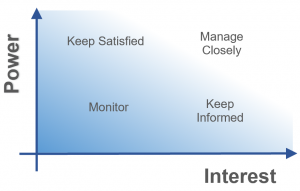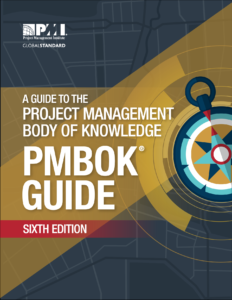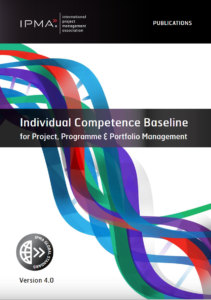
In project management, a stakeholder is anyone who is affected by the project. This can be a real or perceived effect. Some are supportive and some are opposed to the project. Some have alot of influence and some have a little. Some are easy to persuade and some are not.
But they all have a “stake” therefore project success and stakeholder management are integrally linked and the importance of stakeholder management cannot be understated.
A stakeholder, by definition, has the ability to force unexpected, undesirable change to the project, or in the worst case, to stop the project altogether. The goal of project stakeholder management is to avoid this, and also to finish the project with all stakeholders satisfied with the outcome.
Stakeholder Management
Stakeholder management is an art as well as a science. You can create a perfect plan and execute it to perfection, yet still have stakeholders trip up a project. In fact, in real life most stakeholders that are opposed to the project assume that you will have a plan to win them over, and executing it flawlessly can seem uncaring and without empathy.
But you have to start with the science and then apply the art. As far as the science goes, stakeholder management has four main parts:
- Stakeholder Identification
- Stakeholder Analysis
- Stakeholder Control
Stakeholder Identification
 It is surprisingly easy to ignore one key stakeholder that ends up having a disproportionately large ability to derail the project when they don’t feel that they are being adequately consulted. Therefore, identification of all the stakeholders, even the most minor ones, is imperative.
It is surprisingly easy to ignore one key stakeholder that ends up having a disproportionately large ability to derail the project when they don’t feel that they are being adequately consulted. Therefore, identification of all the stakeholders, even the most minor ones, is imperative.
Stakeholders can be classified into four types to allow of ease of identification:
- Upwards
This includes executives from the parent organization, lenders, creditors and shareholders. It also includes the project sponsor, which is the first level of contact at the parent organization outside of the project. These stakeholders wish to see the project succeed as it is a part of their business goals. However, their communication needs vary. - Downwards
These are stakeholders who carry out the project work. It includes the project team, contractors, and suppliers. This group wishes to be fairly compensated for their work, and to leave the project with a slightly better chance at being selected for the next project (or job). That is, references for good work performed, or training that will help with future job prospects. Projects are by definition, temporary, hence the downwards stakeholders wish to leave the project with something more than they started with. - Outwards
These are the traditional stakeholders of a project, and are different for every project. For example, a government regulatory agency, an adjacent landowner, or an environmental agency. End users and customers are also grouped into this category. These can be, but are not always, the same entity. For example, a software development project might have as its customer the owner organization of the software, but the end users are the people who will use the product. Although related, their needs must be treated individually. - Sidewards
This category includes stakeholders who are in competition with the project for limited resources. It includes other project managers (projects), technical department managers who supply the project with resources, unions, trade organizations, committees and boards. These stakeholders are not actively motivated for project success, but not opposed either. Rather, they seek to impose requirements on the project and there are consequences if they are not met.
The end result of the stakeholder identification phase is the production of stakeholder register. This is a simple listing of the project’s key stakeholders.
Stakeholder Analysis
Once they are identified, the stakeholders are analyzed to determine their needs and wants, their roles in the project, and how the project affects them. This falls into three steps:
 Power-Interest Matrix
Power-Interest Matrix
There are two primary variables that define the stakeholder’s relationship with the project: Power and Interest. Power is their ability to change or stop the project, and interest is the size of their overlap with the project’s goals. These two variables are graphed with the interest on the x-axis and the power on the y-axis. The location of each stakeholder is plotted and the results tell you a great deal about how the stakeholder should be managed.- low power, low interest stakeholders need to be monitored to ensure they don’t unduly influence the project.
- low power, high interest stakeholders need to be kept informed to ensure they don’t generate unnecessary influence to other stakeholders.
- high power, low interest stakeholders must be kept satisfied. These stakeholders must have all their needs met to ensure they don’t derail the project over small issues.
- high power, high interest stakeholders are major stakeholders and must be actively managed to ensure they remain supportive.
- Stakeholder motivational factors assessment
A stakeholder analysis requires a consideration of the underlying motivational factors of each stakeholder. These factors can be:- Financial interests
- Moral and ethical values
- Religious beliefs
- Political opinions
- Business interests
- Demographics
- Environmental stewardship
- Value of ownership
- Communication preferences
- Stakeholder Engagement Assessment Matrix
In a perfect world everyone would be supportive of our projects, but unfortunately it’s not a perfect world, therefore every project seems to have at least one opposed stakeholder (if not, I envy you). Supportive stakeholders are easy to deal with and require very little effort, but it’s the opposition to the project that requires the project management team’s time and effort. To track each stakeholder, a stakeholder engagement assessment matrix is used, which shows where the stakeholder is now vs. where the stakeholder needs to go.In this matrix, the five columns correspond to the five possible current locations of the stakeholder: Unaware, opposed, neutral, supportive, and leading. Each stakeholder is placed in one of the columns in relation to their current (C) status, and their desired (D) status.
 When there is a large gap between current (C) and desired (D) locations, the project manager has some work to do.
When there is a large gap between current (C) and desired (D) locations, the project manager has some work to do.
The stakeholder analysis culminates in the production of a stakeholder engagement plan, which provides the analysis and establishes a plan for bringing the stakeholder from their current status to the desired status. This plan might involve regular communication, open houses, production of reports and analyses, monitoring, or anything that will win them over.
Stakeholder Control
Project control refers to those actions that keep the project on schedule and budget. Stakeholder control, as a subset of project control, refers to ensuring that the stakeholder engagement activities are being performed according to plan.
You will never win over every stakeholder, and that is not the goal. The goal is to execute on the plan, so you can show other stakeholders (i.e. the executive, project sponsor, etc.) that you have done due diligence in bringing the opposition stakeholders into the fold.
At project control points, such as weekly progress status points where earned value calculations are done and progress reports submitted to management, the stakeholders should be analyzed to determine if the actions specified in the stakeholder engagement plan have been performed for that status period. If not, corrective action is taken.
If stakeholder engagement needs change, a common occurrence in most projects, the stakeholder engagement plan is updated.
Stakeholder Management in the PMBOK
 One of the Project Management Body of Knowledge‘s (PMBOK) knowledge areas is called Project Stakeholder Management. This reflects the importance of stakeholders in project management. This knowledge area contains 4 processes:
One of the Project Management Body of Knowledge‘s (PMBOK) knowledge areas is called Project Stakeholder Management. This reflects the importance of stakeholders in project management. This knowledge area contains 4 processes:
- Identify Stakeholders
- Plan Stakeholder Engagement
- Manage Stakeholder Engagement
- Monitor Stakeholder Engagement
The first two are contained within the project planning group, the third is within the execution group, and the last is within the project control and monitoring group. This reflects the fact that stakeholder management starts with a planning phase (development of a plan), then proceeds to an implementation phase (during project execution), and during project execution the implementation of the plan is monitored through project control processes.
The PMBOK specifies three documents throughout the knowledge area:
- Stakeholder register
- Stakeholder engagement assessment matrix
- Stakeholder engagement plan
IPMA Individual Competence Baseline
 The International Project Management Association’s Individual Competence Baseline (ICB) for project managers contains a competence item entitled “Stakeholders” (Practice #12). This competence element contains five key competence indicators:
The International Project Management Association’s Individual Competence Baseline (ICB) for project managers contains a competence item entitled “Stakeholders” (Practice #12). This competence element contains five key competence indicators:
- Identify stakeholders and analyze their interests and influence
- Develop and maintain a stakeholder strategy and communication plan
- Engage with the executive, sponsor and higher management to gain commitment and to manage interests and expectations
- Engage with users, partners, suppliers and other stakeholders to gain their cooperation and commitment
- Organize and maintain networks and alliances






